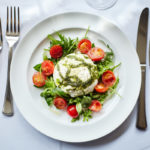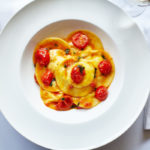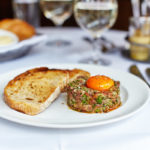Scrambled eggs are one of the most versatile dishes for breakfast. Follow the tips below to find out more on how to cook scrambled eggs on stove.
The truth is that scrambled eggs are easy to make. Unfortunately, they are also the easy to make WRONG. At a root level, scrambled eggs are simply beaten eggs which are fried and – for lack of a better word – scrambled. But like most things that are simple (take love and martinis as examples), people have found ways to make them needlessly complex.
No cheese. No overt flavorings. Just eggs and what it takes to make them taste and look like great eggs.
What NOT To Add
Cottage Cheese – Several recipes I encountered recommended whisking a Tablespoon of small curd cottage cheese in with each egg. Visually, the result was creamy and mildly fluffy scrambled eggs. In terms of taste, the cottage cheese did not contribute or detract from the eggs — but it did make the dish seem somehow impure. You knew there was something in there besides the egg. The aspect of cottage cheese that secured its fate as a stay-out-of-our-scramble ingredient was that no matter how vigorously you whisked the dish had texture irregularities. Every other bite had the unwelcome surprise of a noticeable cottage cheese curd.
Real Cream – I tried two recipes that used real cream (“the fat skimmed off the top of raw milk” as defined by the Wikipedia Dairy Products Guide). One said to add 1 Tablespoon of real cream per egg. The other instructed the use of 1 and ½ Tablespoons of cream per egg. Both recipes created beautiful eggs with a creamy yellow color. Sadly, the resulting flavor was not so beautiful. In both cases the first bite tasted terrific, but the more I ate the more I had to admit that these eggs were just too creamy. The recipe with 1 and ½ Tablespoons of cream left a slight, unpleasant milky after-taste.
Sour Cream – Scrambled eggs with sour cream can not be considered scrambled eggs in a purist sense. The sour cream adds a distinct flavor. Therefore, scrambled eggs with sour cream will be saved for mention in a future article on specialty or flavored scrambled eggs.
Baking Powder – Scrambled eggs with a pinch of baking powder per egg had a great appearance. They were fluffy, yet firm. I was surprised to find there was no trace of baking powder taste. Unfortunately, the texture of the scramble in the mouth was uneven with specks of firmer pieces in a single bite.
Sea Salt – When salt is heated it breaks down to the same components regardless whether its table salt or sea salt. As Robert Wolke says in his book What Einstein Told His Cook, “…when a recipe specifies simply ‘sea salt’ it is a meaningless specification. It might as well be specifying ‘meat’.” If you see a recipe that says to add sea salt to eggs before whisking…. you can be sure it was written by someone who needs to learn more about the ionic bonds that hold sodium and chlorine together.
Sugar – Eggs, flour and sugar are the primary ingredients of a great many deserts. Remove the flour and you end up with neither desert nor scrambled eggs – at least not from a purist scramble perspective. What you do end up with is a kind of specialty egg dish that deserves further exploration in the field of breakfast. It’s not fair to call them scrambled eggs, but their sweetness makes them an interesting complement to pancakes and waffles
What NOT To Do
DON’T beat egg whites until stiff peaks form
With or without added ingredients like sugar and cream of tartar, the result of scrambling looks like a big dollop of melting Crisco crossed with cottage cheese.
DON’T stir eggs slowly for an extended period
I came across one recipe that actually instructed to stir the eggs in the fry pan (heated at your stove’s lowest setting) with a wooden spoon for 30 minutes.
First of all, the eggs didn’t set after 30 minutes at the lowest heat setting. I tried once more at a slightly higher setting. After 10 minutes, the eggs began to show subtle signs of setting. I continued to stir the eggs in the pan for 10 minutes. The result looked more like butternut squash than any eggs I’ve ever seen. The texture was close to chewy and the extended cooking time seemed to have cooked away all the flavor of egg.
Do It Or Don’t – It doesn’t Make a Difference
Keep eggs at room temperature before scrambling – Kitchen tests showed no significant difference between room-temperature and refrigerated eggs from the same carton. Refrigeration actually deters the growth of salmonella enteritis. Even though salmonella is very rare (1 out of every 20,000 eggs may contain the bacteria), it is advised that your eggs always remain stored in the refrigerator.
The Art of Scrambling – Proper Technique
The Best Way To Beat Your Eggs
One of the most important ingredients in scrambled eggs is hardly ever mentioned… air. It would be nice if we could just dollop a Tablespoon of air into the mixing bowl, but for the time-being, incorporating air into beaten eggs requires good old-fashioned elbow grease (or the electric equivalent).
The more you whisk — the more air bubbles become trapped in the shaken and unraveling protein of the eggs. As the eggs cook, protein molecules firm-up around the air bubbles resulting in a spongy texture and hopefully full and fluffy scrambled eggs.
The American Egg Board describes well-beaten eggs as “frothy and evenly colored”. When your eggs match that description (generally after about 2 minutes) you should stop beating.
Over-beating will completely unravel the protein molecules and destabilize their ability to form a microscopic casing around the air. In terms of whisking motion, a tilted wheel motion works far better than a vertical stirring motion. A fork works as well as a whisk but requires a slight bit more time and energy.
The Best Way To Scramble In The Pan
The actions you take once the eggs hit the fry pan will dictate the size of the scrambled egg pieces (curds). Some recipes suggest stirring the eggs with a wooden spoon immediately as the eggs hit the heated surface. Others direct you to let the eggs start to set before stirring/scrambling. Of the two, the second method results in larger fluffier pieces.
Getting Hungry?
Before we scramble our brains contemplating the best plate to eat scrambled eggs off of, the texture differentials of eating with a spoon and the ideal temperature of the chair you sit in as you eat… let’s get back to the reason we’re here. For your breakfast pleasure, The Fish Creek House Presents…
This recipe serves 2 hungry people.
6 large eggs
6 teaspoons (1 teaspoon for each egg) low-fat milk
3 dashes of salt (1 dash for every two eggs)
1 Tablespoon butter for frying
Heat a large non-stick frying pan to a setting just above medium. A 12-inch pan works well for 6 eggs. Do not add butter yet. We just want get the pan ready.
In large metal or glass mixing bowl, whisk the eggs with the milk and salt. Beat vigorously for 2 minutes.
Alternatively, you can place the eggs, milk and salt in a blender and blend for 20 to 25 seconds. Allow the mixture to set for a couple minutes to let the foam settle.
Melt the butter in the frying pan. As the very last of the butter is liquefying, add the egg mixture.
Do not stir immediately. Wait until the first hint of setting begins. Using a spatula or a flat wooden spoon, push eggs toward center while tilting skillet to distribute runny parts.”)
Continue this motion as the eggs continue to set. Break apart large pieces as they form with your spoon or spatula. You will come to a point where the push-to-center technique is no longer cooking runny parts of the egg. Flip over all the eggs. Allow the eggs to cook 15 to 25 seconds longer. Transfer eggs to serving plates. Add salt and pepper to taste. Eat up!









